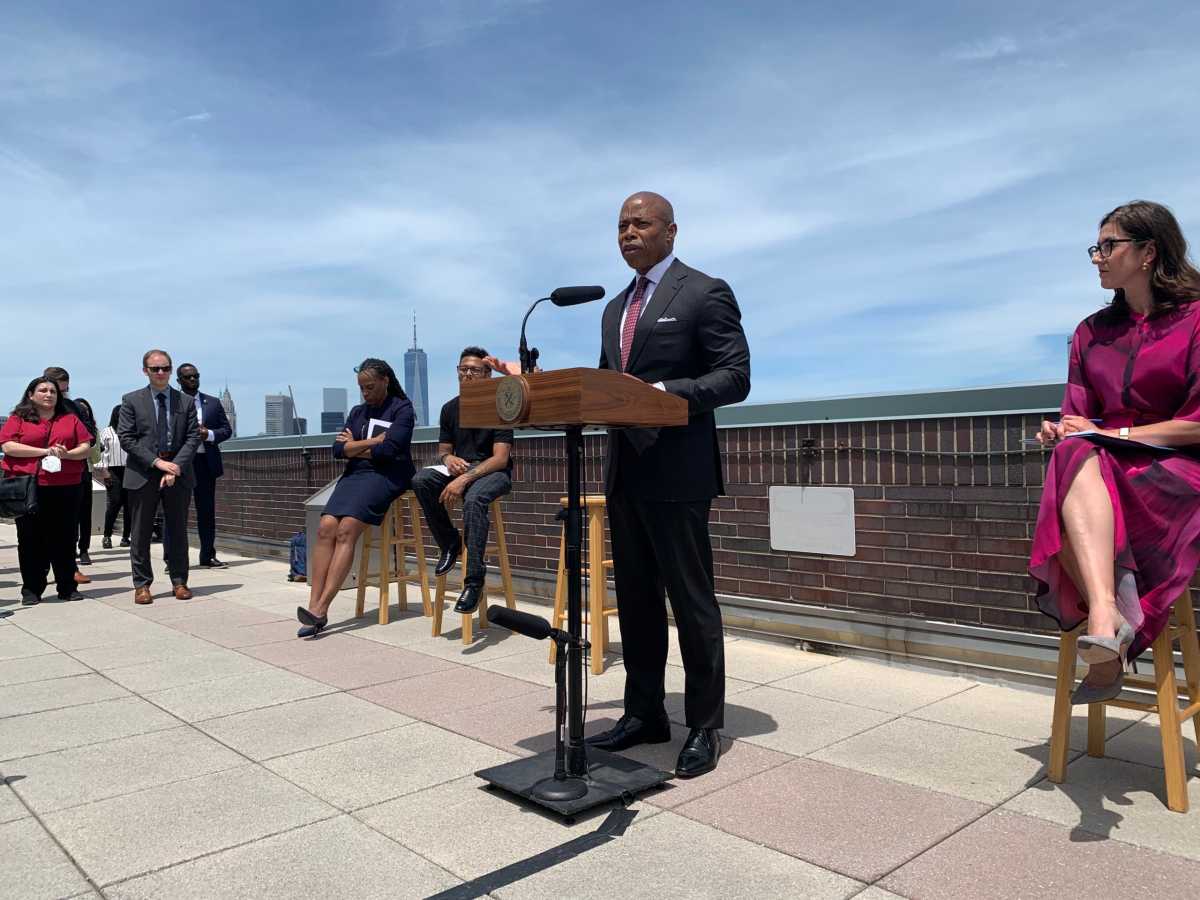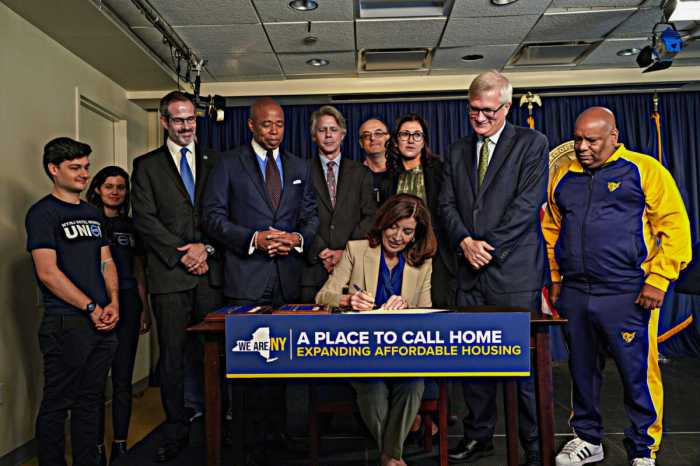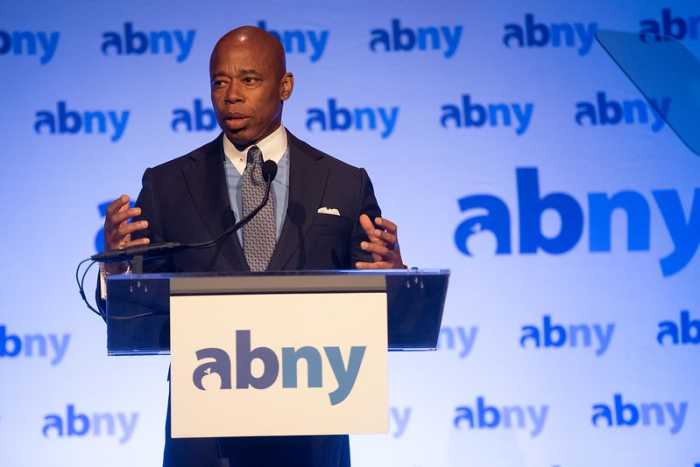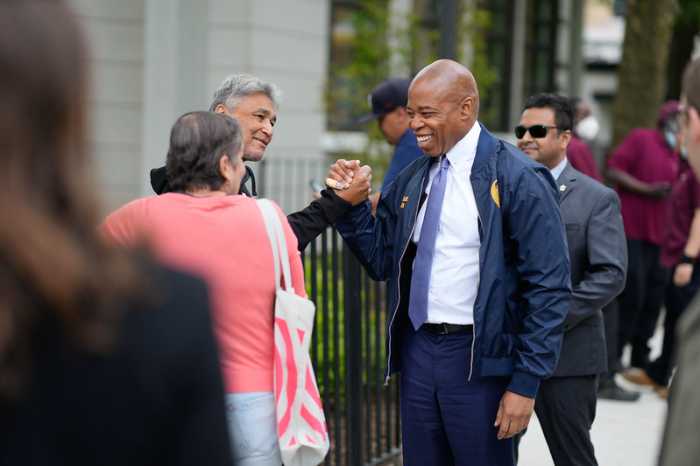Mayor Eric Adams unveiled his plan to address the city’s housing and homelessness crises Tuesday but refused to commit to any clear metrics for the number of affordable housing units that should be built or the number of homeless New Yorkers that should be housed under the plan.
While presenting his ‘Housing Our Neighbors: A Blueprint for Housing and Homelessness” plan on the rooftop of 90 Sands St. – a former Jehovah’s Witnesses owned hotel that was acquired by the city and converted into 490 units of supportive and affordable housing – Hizzoner said the plan doesn’t have any target number for how many supportive and affordable housing units his administration aims to build and he wouldn’t take any questions on the subject.
“It’s often asked, ‘how many units you gonna build? How many units you gonna build? how many units you gonna build?’” the mayor said. “If that is one of the on topic questions you are going to ask me, don’t, because I’m not answering that. How many people we gonna put in housing? We need to put people in housing. That’s the focus that we are on.”
When asked by a reporter about what Adams would consider a successful number of people to be placed in supportive housing under the plan, he again refused to give a specific number and only said “as many as possible to get into housing.”
“If you say 30,000 and you have 50,000 that are homeless, then what kind of success is that?” I got 20,000 people that are not,” Adams said. “So, I’m not at this magic number. I’m going to get as many people in my four years to get into housing as possible. And I’m not playing these numbers of ‘what is this number?’ No. Everyone needs to find housing. Those are my goals.”
Adams was joined by the city’s Chief Housing Officer Jessica Katz, city Department of Housing Preservation and Development (HPD) Commissioner Adolfo Carrión Jr., New York City Housing Authority (NYCHA) Chair and CEO Gregory Russ and Shams DaBaron – a homeless advocate known as the “Homeless Hero.”
Adams said the plan is the first in the city’s history to include improvements to NYCHA developments in addition to the creation and preservation of the city’s affordable housing stock. Like many other of Adams’ initiatives, the plan also seeks to streamline processes by cutting down on paperwork and bureaucracy.
The plan builds on the fiscal year 2023 adoptive budget, passed by the City Council late Monday night, which allocates $22 billion for building and maintaining affordable housing over the next ten years. This allocation fell short of the $4 billion-a-year the council was seeking in its budget response.
The mayor also touted the fact that his administration held roundtables with New Yorkers who have experienced homelessness, whose input was important to drafting the plan.
“The roundtables were amazing,” Adams said. “Sitting down in City Hall with those who lived the life and hearing from them. We sat down and we listened to them. And it was a very compassionate, very thorough conversation that came from them. This continuation of listening to people is the hallmark of this administration.”
The housing plan itself, Adams said, is divided into five sections: improving NYCHA, addressing homelessness, building and preserving affordable housing, and reducing the administrative burden of finding housing.
On transforming NYCHA, Adams said the plan calls for using the federal dollars unlocked by the recently passed NYCHA Preservation Trust to make the much-needed $40 billion in repairs at NYCHA developments across the city. It also aims to center NYCHA residents in the decision making process and to use technology to monitor the success of the improvements to NYCHA outlined in the plan.
When it comes to reducing homelessness, the plan calls for accelerating the creation of 15,000 units of supportive housing by 2028, two years ahead of the 2030 target. The plan also promises to break down barriers between city agencies and create new metrics, so they can better work together to address homelessness.
This includes, Katz said, for the first time conducting an “accurate” homelessness census.
“Too often, government has tried to get cute with these numbers and not acknowledge the reality of our homelessness problem,” Katz said. “We’ve always just looked away and swept it under the rug until now.”
The plan also calls for increasing affordable homeownership, particularly in Black and brown communities, the mayor said.
“I want to put the dream of home ownership back in the hands of working people and remind New Yorkers, that leaving the city isn’t an option,” Adams said. “We have a hemorrhaging of Black and brown families leaving New York because it’s no longer affordable. We’ve decimated the middle class. And we need to refocus our attention on stabilizing these families and stabilizing the city that they made prosperous.”
Not everyone was pleased with Adams’ housing plan. In a statement, Jacquelyn Simone, the Policy Director for the Coalition for the Homeless, said that while Adams’ blueprint took steps in the right direction towards addressing the city’s housing crisis, it didn’t go nearly far enough, while also decrying the Adams’ administration’s sweeps of homeless encampments.
“Mayor Adams must dramatically expand the supply of permanent and supportive housing for homeless New Yorkers and extremely low-income households – which takes far bolder housing investments than are included in this plan,” Simone said. “We also call on the Mayor to recognize the dignity and humanity of those who will continue to feel safer sleeping on the streets until they can obtain permanent housing by ceasing the cruel and counterproductive sweeps that merely criminalize the most vulnerable among us.”










